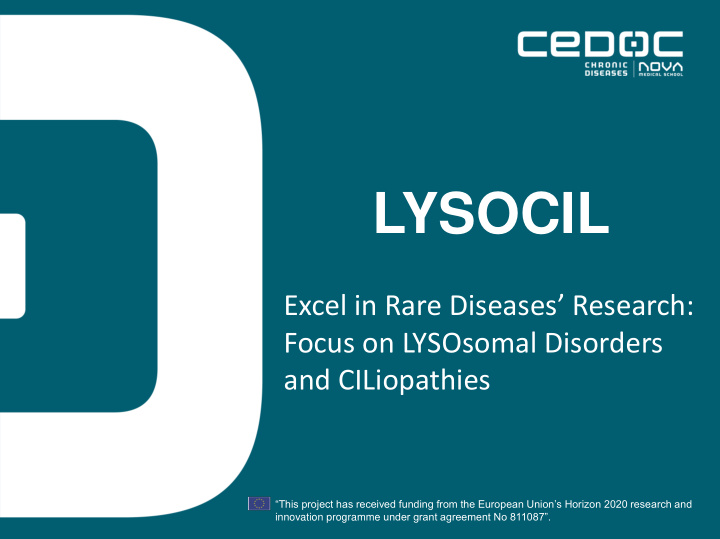



LYSOCIL Excel in Rare Diseases’ Research: Focus on LYSOsomal Disorders and CILiopathies “This project has received funding from the European Union’s Horizon 2020 research and innovation programme under grant agreement No 811087”.
LYSOCIL Overview Proposal Title: Excel in Rare Diseases ’ Research: Focus on LYSO somal Disorders and CIL iopathies Proposal Acronym: LYSOCIL Topic reference: WIDESPREAD-05-2017: Twinning Call Identifier: H2020-WIDESPREAD-2016-2017 Project Coordinators: Duarte Barral/Susana Lopes (CEDOC) Consortium: Dates: November 2018 - November 2021 Total investment: EUR 967,572.50
LYSOCIL Consortium 7 Research groups 13 Research groups 8 Research groups LYSOCIL External Advisory Board Gregory Pazour Miriam Schmidts University of Massachusetts (USA) Radboud University (NL) Claire Hogg Paul Luzio Royal Brompton and Harefield (UK) University of Cambridge (UK) Frances Platt Margarida Laygue University of Oxford Raríssimas (PT) (UK)
CEDOC Research Groups Duarte Barral: Susana Lopes: Cilia Membrane Traffic in Regulation and Disease Infection and Disease Miguel Seabra: Paulo Pereira: Molecular Mechanism Proteostasis and of Disease Proteolytic Signaling Otília Vieira: Cláudia Almeida: Lysosomes in Chronic Neuronal Trafficking in Human Pathologies Aging and Infection Helena Vieira: Cell Death and Disease
WWU Research Groups Heymut Omran: Molecular and functional analysis of primary ciliary dyskinesia (PCD) + Heike Olbrich + Niki Tomas Loges + Gerard Dougherty + Julia Wallmeier + Petra Pennekamp + Tabea Nöthe-Menchen + Sandra Cindric Martin Konrad: Inherited Renal Tubular Disorders Jens König: Cystic Kidney Diseases of the Childhood Karl Peter Schlingmann Inherited Renal Tubular Disorders Uwe Hansen: Electron Microscopy Frank Rutsch: Rare Pediatric Metabolic and Autoimmune Disorders Bernd Dworniczak: Human Genetics
TIGEM Research Groups Antonella De Matteis: Cell Biology and Disease Mechanisms + Leopoldo Staiano Roman Polishchuck: Advanced Microscopy and Imaging Core + Lena Polishchuck Carmine Settembre: Lysosomal Processes in Skeletal Development and Diseases + Giorgia Di Lorenzo Diego Medina: Lysosomal Calcium Signalling and Autophagy + Simone Di Paola Jlenia Monfregola: Modulating Cellular Clearance to Treat Human Disease (Andrea Ballabio group) Graciana Diez-Roux: TIGEM Scientific Office + Bianca Fontanella + Barbara Zimbardi Cristina Nicolina Sorrentino: Preclinical studies and Translational Unit
LYSOCIL Main Goal The overall aim is to strengthen the research and innovation capacity of CEDOC , capacitating it to become a national and internationally-recognized Centre of Excellence in Chronic RD research and innovation.
LYSOCIL Objectives To intensify intramural collaboration To strengthen the research quality and innovation , while promoting multidisciplinary projects within and beyond CEDOC To provide an exciting research environment for the training of postdoctoral fellows, PhD and Master students and raise the research and academic profile of CEDOC and of all the partners’ staff To foster the organization of outreach activities at local and national levels
LYSOCIL Scientific Axes Rare Diseases affect less than 1 in 2,000 newborns (30M people affected in Europe) and only 500/7000 have therapies available. Focus on “horizontal diseases” : → AXIS 1: Lysosome Biology and Lysosomal Disorders. (Otília Vieira, Miguel Seabra, Duarte Barral, Paulo Pereira, Cláudia Almeida) → AXIS 2: Cilia Biology, Primary and Motile Ciliopathies. (Susana Lopes, Duarte Barral) → AXIS 3: Autophagy, Mitophagy, Cell Metabolism and Implication in RDs. (Helena Vieira)
LYSOCIL Scientific Axes Lysosomal Disorders Ciliopathies → Lysosomal-Storage Disorders : rare and recessively → Primary ciliary dyskinesia: rare genetic disorder inherited metabolic dysfunctions. Often associated with caused by inherited defects in motile ciliary severe neurodegeneration, mental decline, cognitive function. Characterized by recurrent respiratory problems and behavioral abnormalities. infections, it typically progresses to bronchiectasis → Griscelli Syndrome : divided in 3 sub-types - GS1, GS2 and can result in chronic lung failure in adulthood. and GS3 - caused by mutations in MYO5A , RAB27A or → Polycystic kidney disease : genetic disorder in MLPH . All the forms present hypopigmentation of the which the renal tubules become structurally hair and skin, and in the case of GS2 also immune abnormal, resulting in the development and dysfunction. growth of multiple cysts in the kidneys. → Hermansky-Pudlak Syndrome : Patients present a → Joubert syndrome : disorder of brain combination of albinism and bleeding diathesis. development that affects many parts of the body → Choroideremia: rare X-linked retinal degeneration and it is characterized by the absence or caused by mutations in Rab-escort protein 1 ( REP1 ). underdevelopment of the cerebellar vermis and a This disease is a good candidate for treatment by gene malformed brain stem. therapy.
LYSOCIL Implementation
Activities Research career mentoring programme Short-term missions ( e.g. CEDOC Research Funding Office) Virtual think tanks Training workshops (lysosome biology, drug screening, transmission electron microscopy and outreach & fundraising) Summer school Winter retreats LYSOCIL satellite meetings CEDOC open day on the Rare Disease day - 29 th February 202 Student annual competition on Rare Diseases for the presentation of creative ideas around these diseases Fundraising - research on Rare Diseases Staff exchange programme
Staff Exchanges Feb/Mar Training on distinguishing true genetic PCD from secondary ciliary dyskinesia 2019 May/Jul 2019 Training on induced pluripotent stem cells (iPSC) Sep 2019 Training in immunostainings pioneered by Omran ’ lab Nov 2019 Training on the analysis of lysosome morphological changes Jan 2020 Training on mitophagy analysis under the context of mitochondrial diseases Mar 2020 Training on cross-talk between cilia and autophagy May/Aug Training on the characterization of lysosome-related organelles 2020 Dec/Jan 2021 Genotyping for the identification of genes that cause ciliopathies
LYSOCIL Expected Outputs Increase the number of publications in top 10% peer reviewed journals and citations Increase the number and success rate of national and international research grant applications , the number of oral or poster communications during scientific meetings and of invitations to national and international conferences Increase the number of new collaborations within and outside LYSOCIL, of new international researchers and PhD students , and of PhD students and post-docs with international fellowships Increase the number of local, national and international outreach activities , of participants in outreach events, of newsletter and social networks’ followers and of online and printed media pieces
Recommend
More recommend